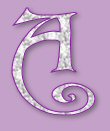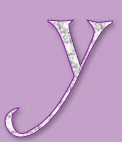This
glossary is hardly comprehensive,
and I don't think you'll ever find
one which is. It's a bit of a work
in progress, something I'm constantly
adding to. Some of the definitions
are my own work, others are widely
available definitions. Click on a
letter below to go to that section
of the list, or just scroll through.
A
B C
D E
F G
H I
J K
L M
N O
P Q
R S
T U
V W
X Y
Z

Akasha:
The fifth element, the omnipresent
spiritual power that permeates the
universe. It is the energy out of
which the Elements formed.
Amulet:
A magickally charged object which
deflects specific, usually negative
energies. Generally, a protective
object.
Ankh:
An Egyptian hieroglyphic that is widely
used as a symbol for life, love, and
reincarnation. It is depicted as a
cross with a looped top. When worn
or carried, the ankh brings good health,
promotes fertility, and strengthens
the psychic powers.
Asperger:
A bundle of fresh herbs or a perforated
object used to sprinkle water during
or preceding ritual, for purificatory
purposes.
Athame:
"ah-THAW-may". A Wiccan
ritual knife. It usually has a double-edged
blade and a dark handle. The athame
is used to direct personal power during
ritual workings. 

Balefire:
A fire lit for magickal purposes,
usually outdoors. Balefires are traditional
on Yule, Beltane and Midsummer.
Bane:
That which destroys life, which is
poisonous, destructive, evil, dangerous.
Beltane:
A Wiccan festival celebrated on April
30th or May 1st. Beltane is also known
as May Eve, Roodmas. Beltane celebrates
the symbolic union, mating or marriage
of the Goddess and God, and links
in with the approaching summer months.
Besom:
Broom
Bolline:
The white-handled knife, used in magick
and Wiccan ritual for practical purposes
such as cutting herbs.
Book
of Shadows: A Wiccan book of rituals,
spells and magickal lore. Once hand
copied upon initiation, the BOS is
now photocopied or typed in some covens.
No one "true" BOS exists;
all are relevant to their respective
users.


Censer:
A heat-proof container in which incense
is smouldered. An incense burner.
It symbolized the Element of Air.
Charge,
To: To infuse an object with personal
power. "Charging" is an
act of Magick.
Conscious
Mind: The analytical, materially-based,
rational half or our consciousness.
The mind at work when we compute our
taxes, theorize or struggle with ideas.
Coven:
A group of Wiccans, usually initiatory
and led by one or two leaders.
Craft,
The: Wicca. Witchcraft. Folk magick.


Deosil:
Clockwise, the direction of the Sun's
apparent motion in the sky.
Divination:
The magickal art of discovering the
unknown by interpreting random patterns
or symbols through the use of tools
such as clouds, tarot cards, flames,
smoke. Divination contacts the psychic
mind by tricking or drowsing the conscious
mind through ritual and observation
or of manipulation of tools. Divination
isn't necessary for those who can
easily attain communication with the
psychic mind, though they may practice
it.
Divine
Power: The unmanifested, pure
energy that exists within the Goddess
and God. The life force, the ultimate
source of all things.


Earth
Power: That energy which exists
within stones, herbs, flames, wind
and other natural objects. It is manifested
divine power and can be utilized during
magick to create needed change.
Elements:
The: Earth, Air, Fire, Water. These
four essences are the building blocks
of the universe. Everything that exists
(or that has potential to exist) contains
one or more of these energies. The
elements hum within ourselves and
are also "at large" in the
world. They can be utilized to cause
change through magick. The four elements
formed from the primal essence of
power- Akasha.
Esbat:
A Wiccan ritual, usually occurring
on the Full Moon.
Evocation:
Calling up spirits or other non-physical
entities, either to visible appearance
or invisible attendance.


There
are no entries under this heading.


Grimoire:
A magickal workbook containing ritual
information, formulae, magickal properties
of natural objects and preparation
of ritual equipment.


Handfasting:
A Wiccan, Pagan or Gypsy wedding.


Imbolc:
A Wiccan festival celebrated on February
2nd, also known as Candlemas, Feast
of Pan and many other names. Imbolc
celebrates the first stirrings of
spring and recovery of the Goddess
from giving birth to the Sun (the
God) at Yule.
Initiation:
A process whereby an individual is
introduced or admitted into a group,
interest, skill or religion. Initiations
may be ritual occasions but can also
occur spontaneously.
Invocation:
An appeal or petition to a higher
power (or powers), such as the Goddess
and God. A prayer. Invocation is actually
a method of establishing conscious
ties with those aspects of the Goddess
and God that dwell within us. In essence,
then, we seemingly cause them to appear
or make themselves known by becoming
aware of them.


There
are no entries under this heading.


Kahuna:
A practitioner of the old Hawaiian
philosophical, scientific and magickal
system.

Labrys:
A double-headed axe which symbolized
the Goddess in ancient Crete, still
used by some Wiccans for this same
purpose. The labrys may be placed
on or leaned against the left side
of the altar.
Lughnasadh:
A Wiccan festival celebrated on August
1st, also known as August Eve, Lammas.
Lughnasadh marks the first harvest,
when the fruits of the Earth are cut
and stored for the dark winter months,
when the God also mysteriously weakens
as the days grow shorter.

Mabon:
On or around September 21st, the autumn
equinox, Wiccans celebrate the second
harvest. Nature is preparing for winter.
Mabon is a vestige of ancient harvest
festivals which, in some form or another,
were once nearly universal among peoples
of the Earth.
Magick:
The movement of natural energies to
create needed change. Energy exists
within all things- ourselves, plants,
stones, colors, sounds, movements.
Magick is the process of rousing or
building up this energy, giving it
purpose, and releasing it. Magick
is a natural, not supernatural, practice,
though it is little understood.
Magick
Circle, The: A sphere constructed
of personal power in which Wiccan
rituals are usually enacted. The term
refers to the circle that marks the
sphere's penetration of the ground,
for it extends both above and below
it. It is created through visualization
and magick.
Meditation:
Reflection, contemplation, turning
inward toward the self or outward
toward Deity or nature. A quiet time
in which the practitioner may dwell
upon particular thoughts or symbols,
or allow them to come unbidden.
Megalith:
A huge stone monument or structure.
Stonehenge is perhaps the best-known
example of megalithic construction.
Menhir:
A standing stone probably lifted by
early peoples for religious, spiritual
or magickal reasons.
Midsummer:
The summer solstice, usually on or
near June 21st, one of the Wiccan
festivals and an excellent night for
magick. Midsummer marks the point
of the year when the Sun is symbolically
at the height of its powers, and so
too the God. The longest day of the
year.
Mighty
Ones, The: Being, deities or presences
often invoked during Wiccan ceremony
to witness or guard the rituals. The
Mighty Ones are thought to be either
spiritually evolved beings, once human,
or spiritual entities created by or
charged by the Goddess and God to
protect the Earth and to watch over
the four directions. They are sometimes
linked with the Elements.


Neo-Pagan:
Literally, new-Pagan. A member, follower
or sympathizer of one of the newly
formed Pagan religions now spreading
throughout the world. All Wiccans
are Pagan, but not all Pagans are
Wiccan.


Old
Ones, The: A Wiccan term often
used to encompass all aspects of the
Goddess and God. Some Wiccans view
it as an alternative of The Mighty
Ones.
Ostara:
Occurring at the spring equinox, around
March 21st, Ostara marks the beginning
of true, astronomical spring, when
snow and ice make way for green. As
such, it is a fire and fertility festival,
celebrating the return of the Sun,
and God and the fertility of the Earth
(the Goddess). 

Pagan:
From the Latin paganus, country-dweller.
Today used as a general term for followers
of Wicca and other magickal, shamanistic
and polytheistic religions. Naturally,
Christians have their own peculiar
definition of this word. It can be
interchanged with Neo-Pagan.
Pendulum:
A divinatory device consisting of
a string attached to a heavy object,
such as a quartz crystal, root or
ring. The free end of the string is
held in the hand, and the elbow steadied
against a flat surface, and a question
is asked. The movement of the heavy
object's swing determines the answer.
A rotation indicates yes or positive
energy. A back and forth swing signals
the opposite. (There are many methods
of deciphering the pendulum's movement;
use those that work best for you.)
It is a tool which contacts the psychic
mind.
Pentacle:
A ritual object (usually a circular
piece of wood, metal, clay, etc.)
upon which a five-pointed star (Pentagram)
is inscribed, painted or engraved.
It represents the Element of Earth.
The words "pentagram" and
"pentacle" are not interchangeable,
though they understandable cause some
confusion.
Personal
Power: That energy which sustains
our bodies. It ultimately originates
from the Goddess and God (or, rather,
the power behind Them). We first absorb
it from our biological mothers within
the womb and, later, from food, water,
the Moon and Sun and other natural
objects. We release personal power
during stress, exercise, sex, conception
and childbirth. Magick is often a
movement of personal power for a specific
goal.
Polarity:
The concept of equal, opposite energies.
The Eastern yin/yang is a perfect
example. Yin is cold; yang is hot.
Other examples of polarity: Goddess/God,
night/day, Moon/Sun, birth/death,
dark/light, psychic mind/conscious
mind. Universal balance.
Projective
Hand, The: The hand that is normally
used for manual activities such as
writing, peeling apples and dialing
telephones is symbolically thought
to be the point at which personal
power is sent from the body. In ritual,
personal power is visualized as streaming
out form the palm or fingers of the
hand for various magickal goals. This
is also the hand in which tool such
as the athame and wand are held. Ambidextrous
persons simply choose which hand to
utilize for this purpose.
Psychic
Mind: The subconscious or unconscious
mind, in which we receive psychic
impulses. The psychic mind is at work
when we sleep, dream and meditate.
It is our direct link with the Goddess
and God and with the larger, non-physical
world around up. Other related terms:
Divination is a ritual process which
utilizes the Conscious Mind to contact
the psychic mind. Intuition is a term
used to describe psychic information
which unexpectedly reaches the conscious
mind.
Psychism:
The act of being consciously psychic,
in which the psychic mind and conscious
mind are linked and working in harmony.
Ritual consciousness is a form of
psychism. 

There
are no entries under this heading.


Receptive
Hand: The left hand in right-handed
persons, the reverse for left-handed
persons. This is the hand through
which energy is received into the
body.
Reincarnation:
The doctrine of rebirth. The process
of repeated incarnations in human
form to allow evolution of the sexless,
ageless soul.
Ritual:
Ceremony. A specific form of movement,
manipulation of objects or inner processes
designed to produce desired effects.
In religion, ritual is geared toward
union with the divine. In magick it
produces a specific state of consciousness
which allows the magician to move
energy toward needed goals. A spell
is a magickal ritual.
Ritual
Consciousness: A specific, alternate
state of awareness necessary to the
successful practice of magick. The
magician achieves this through the
use of visualization and ritual. It
denotes a state in which the conscious
mind and psychic mind are attuned,
in which the magician sense energies,
gives them purpose and released them
toward the magickal goal. It is a
heightening of the senses, an awareness-expansion
of the seemingly non-physical world,
a linking with nature and with for
forces behind all conceptions of Deity.
Runes:
Stick-like figures, some of which
are remnants of the old Teutonic alphabets.
Others are pictographs. These symbols
are once again widely being used in
magick and divination. 

Sabbat:
A Wiccan festival. See Beltane, Imbolc,
Lughnasadh, Mabon, Midsummer, Ostara,
Samhain and Yule for specific descriptions.
Samhain:
A Wiccan festival celebrated on October
31st, also known as November Eve,
Hallowmas, Halloween, Feast of Souls.
Samhain marks the symbolic death of
the Sun God and His passing into the
"land of the young," where
He awaits rebirth of the Mother Goddess
at Yule. This Celtic word is pronounced
by Wiccan as: SOW-wen; SEW-wen; SAHM-hain;
SAHM-ain; SAV-een and other ways.
The first seems to be the one preferred
among most Wiccans.
Scry,
To: To gaze at or into an object
(a quartz crystal sphere, pool of
water, reflection, a candle flame)
to still the conscious mind and to
contact the psychic mind. This allows
the scryer to become aware of possible
events prior to their actual occurrence,
as well as of previous or distant,
simultaneous events through other
than the normally accepted senses.
A form of divination.
Shaman:
A man or woman who has obtained knowledge
of the subtler dimensions of the Earth,
usually through periods of alternate
states of consciousness. Various types
of ritual allow the shaman to pierce
the veil of the physical world and
to experience the realm of energies.
This knowledge lends the shaman the
power to change her or his world through
magick.
Shamanism:
The practice of shamans, usually
ritualistic or magickal in nature,
sometimes religious.
Simple
Feast, The: A ritual meal shared
with the Goddess and God.
Spell:
A magickal ritual, usually non-religious
in nature and often accompanied by
spoken words.
Spirits
of the Stones, The: The elemental
energies naturally inherent at the
four directions of the magick circle,
personified within the standing stones
tradition as the "Spirits of
the Stones." They are linked
with the Elements


Talisman:
An object, such as an amethyst crystal,
ritually charged with power to attract
a specific force or energy to its
bearer.
Tradition,
Wiccan: An organized, structured,
specific Wiccan subgroup, usually
initiatory, with often unique ritual
practices. Many traditions have their
own book of shadows and may or may
not recognize members of other traditions
as Wiccan. Most traditions are composed
of a number of covens as well as solitary
practitioners.
Trilithon:
A stone arch made from two upright
slabs with one lying atop these. Trilithons
are featured in Stonehenge as well
as the circle visualization in The
Standing Stones Book of Shadows.


There
are no entries under this heading.


Visualization:
The process of forming mental images.
Magical visualization consists of
forming images of needed goals during
ritual. Visualization is also used
to direct personal power and natural
energies during magick for various
purposes, including charging and forming
the magick circle. It is a function
of the conscious mind.


White-Handled
Knife: A normal cutting knife,
with a sharp blade and white handle.
It is used within Wicca to cut herbs
and fruits, to slice bread during
the simple feast and for other functions.
Sometimes called the bolline.
Wicca:
A contemporary Pagan religion with
spiritual roots in Shamanism and the
earliest expressions of reverence
of nature. Among its major motifs
are: reverence for the Goddess and
God; reincarnation; magick; ritual
observances of the Full Moon, astronomical
and agricultural phenomena; spheroid
temples, created with personal power,
in which rituals occur.
Widdershins:
Anti-clockwise motion, usually used
in the Northern Hemisphere for negative
magickal purposes or for dispersing
negative energies or conditions such
as disease.
Witch:
Anciently, a European practitioner
of the remnants of pre-Christian folk
magick, particularly that relating
to herbs, healing, wells, rivers and
stones. One who practiced Witchcraft.
Later, this term's meaning was deliberately
altered to denote demented, dangerous,
supernatural beings who practiced
destructive magick and who threatened
Christianity. This change was a political,
monetary and sexist move on the part
of organized religion, not a change
in the practices of Witches. This
later, erroneous meaning is still
accepted by many non-Witches. It is
also, somewhat surprisingly, used
by some members of Wicca to describe
themselves.
Witchcraft:
The craft of the Witch-magick, especially
magick utilizing personal power in
conjunction with the energies within
stones, herbs, colors and other natural
objects. While this may have spiritual
overtones, Witchcraft, using this
definition, isn't a religion. However,
some followers of Wicca use this word
to denote their religion.


There
are no entries under this heading.


Yule:
A Wiccan festival celebrate on
or about December 21st, marking the
rebirth of the Sun God from the Earth
Goddess. A time of joy and celebration
during the miseries of winter. Yule
occurs on the winter solstice.


There
are no entries under this heading.


